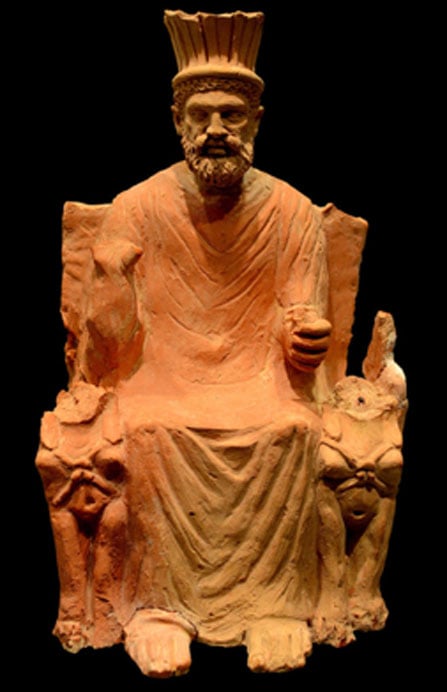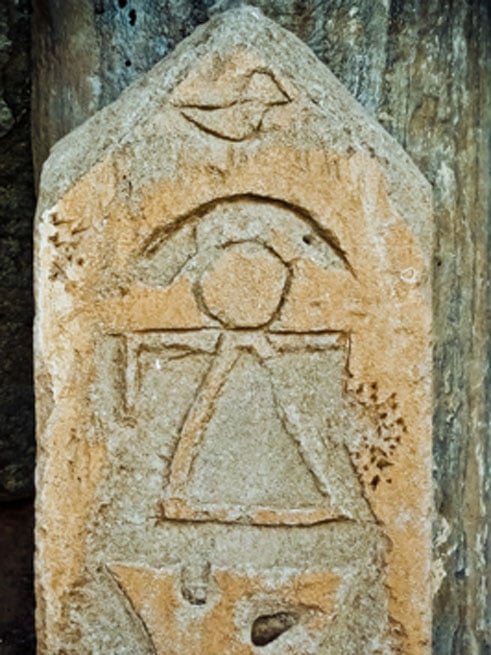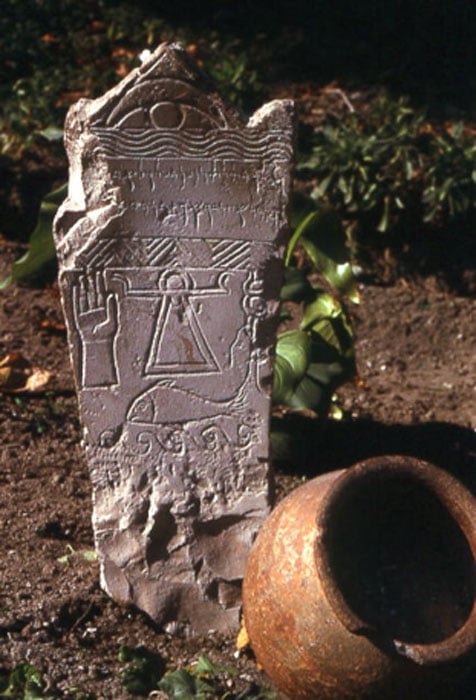
Gods of Carthage and The Punic Power House of Baal Hammon and Tanit
According to tradition, the city of Carthage was founded in 814 BC by the legendary Queen Dido. The founder of this city was originally a princess from the Phoenician city of Tyre. She was, however, forced to flee from her native city. With a band of followers, she sailed across the Mediterranean in search of a new home.
The Tyrian refugees eventually arrived in North Africa, on the coast of what is today Tunisia, and established the city of Carthage. Among other things, the Tyrian settlers brought with them their religious beliefs and practices from their original home. Thus, the religion of Carthage may be said to have a connection with that of its mother city and is related to that practiced by the Phoenicians and Canaanites.
The best-known account of the founding of Carthage is in Virgil’s Aeneid. In the epic poem, the Trojan hero Aeneas flees from Troy after its destruction by the Greeks and wanders around the Mediterranean. During his sojourn, Aeneas and his men arrive at Carthage, where he meets Queen Dido. The story of Aeneas and Dido ends in tragedy, as the queen falls in love with Aeneas, but he has to carry on his journey to the Italian Peninsula. As a result, Dido commits suicide.
Prior to her meeting with Aeneas, Dido was a princess of Tyre, a Phoenician city state. In some sources she is known as Elissa. Virgil states that Dido’s father was Belus and that she had a brother, Pygmalion. In addition, she was married to a man by the name of Sychaeus.

In Virgil’s Aeneid, the epic poem conveys the story of the Trojan hero Aeneas fleeing from Troy. (Blackcat / Public Domain)
Belus had planned to divide the kingdom between his two children after he died. Upon the old king’s death, however, Pygmalion seized power for himself and killed Sychaeus for his wealth. Pygmalion regarded his sister as a threat to his power as well and prepared to murder her. Fortunately, Sychaeus’ ghost appeared to Dido in a dream and told her the truth about his death. He also revealed to her the location where he had hidden his wealth and warned her to flee the city.
Once Dido had retrieved her husband’s wealth, she fled from Tyre with a group of loyal followers. Dido sailed across the Mediterranean and eventually arrived on the shores of North Africa, where she founded the city of Carthage.
The Gods of Carthage and Tyre
As the founders of Carthage were from Tyre, they brought along with them the religion and belief system of their mother city. Therefore, similarities can be found between religious beliefs of the Carthaginians and Tyrians. This is most visible in the gods worshipped by these two peoples.
The Carthaginians, Tyrians, and Phoenicians as a whole, were polytheists and believed in a pantheon of gods. Many of the gods worshipped in Carthage were derived from the Tyrian pantheon, though they were localized and given local names. The two most important gods worshipped in Carthage were Baal Hammon and Tanit, who together formed the supreme divine couple of the Punic pantheon. The Tyrian of these two gods have been identified as Baal and Astarte (or one of her attendants).
- The Sumerian Seven: The Top-Ranking Gods in the Sumerian Pantheon
- 2,000-Year-Old Cooling System for Chariot Horses Unearthed at Ancient Carthage Site
- The Infinite Ogdoad: The Creation Pantheon of Ancient Egypt and Predecessor Gods of the Old Kingdom

Temple in Carthage used to worship the gods of the Punic pantheon. (Stemoir / Adobe Stock)
Baal Hammon, King of the Gods
The name Baal Hammon has been interpreted by scholars to mean ‘Lord of the Brazier’ or ‘Lord of the Altar of Incense’. He was considered to be a god of fertility and worshipped by the Carthaginians as the king of the gods. Baal Hammon was but one version of the deity Baal. This god is found in the pantheons of many ancient Middle Eastern communities and was worshipped especially by the Canaanites, which the Phoenicians were a part of.
Like Baal Hammon, the Baal of the Middle East was believed to be a fertility god, though he was not considered to be the leader of the gods in the Canaanite pantheon. Instead, that title was held by El, whose consort was Asherah. As Baal Hammon was also the king of the gods, some scholars have also speculated that he was the Punic equivalent of El.

Baal Hammon, king of the Punic pantheon, on his throne with a crown and flanked by sphinxes. (Dyolf77 / CC BY-SA 4.0)
The role played by Baal in ensuring the fertility of the land is reflected in one of his titles, ‘Lord of Rain and Dew’, which were the two forms of moisture that the Canaanite farmers depended on. Rain was probably the more vital of the two, as Baal was also regarded to be a storm god. This is visible in the epithet given to him in Ugaritic and Hebrew, ‘He who Rides on the Clouds’, as well as the name given to him by the Phoenicians, ‘Baal Shamin’, meaning ‘Lord of the Heavens’.
Other gods who were known as Baal include Baal Qarnem, Baal Iddir, and Baal Oz. It is unclear, however, whether these were different forms of Baal or distinct deities in their own right.
Tanit, The Consort That Out Shone the King of the Gods
The consort of Baal Hammon was Tanit, who is usually said to have been the equivalent of the Canaanite goddess Astarte. Tanit was not originally part of the Punic pantheon and her worship only began after the 5th century BC. Nevertheless, she soon superseded Baal Hammon in importance. This is seen, for instance, in Carthaginian monuments where her name is often placed before that of Baal Hammon.
Tanit is considered to be the consort of Baal Hammon, one of her titles being ‘face of Baal’. Although Tanit was worshipped as a celestial goddess, the Carthaginians also believed that she was a mother goddess who governed fertility, as her representations are often accompanied by fertility symbols.
The most unique aspect of Tanit is that she is the only Punic deity known to be represented by a symbol. Tanit’s symbol is easily recognized and consists of a triangle / trapezium with a horizontal line and circle above it. Scholars are of the opinion that the symbol represents a stylized female figure with outstretched arms.

Symbol of Tanit, the consort to the king of the Punic pantheon. (mrholle / CC BY-SA 2.0)
The Tyrian God Invasion
Another important deity in the Punic pantheon was Melqart (known also as Tyrian Baal), the chief deity and protector of Tyre. Some scholars speculate that for the Carthaginians, Melqart and Baal Hammon were in fact one and the same. The cult of Melqart helped to maintain the link between Carthage and its mother city.
For the first few centuries of its existence, Carthage was obliged to send one-tenth of its annual profit to the Temple of Melqart in Tyre as tribute. Additionally, the Carthaginians and Tyrians would come together in Tyre each year to celebrate the resurrection of Melqart in a festival referred to by Greek authors as ‘Egeris’.
Other important Phoenician deities brought from Tyre to Carthage included Eshmun, Reshef, and Rasap. Eshmun has been recognized as the equivalent of Adonis and the Greeks have identified him as being similar to their own god of healing, Asclepius. In Sidon, the mother city of Tyre, Eshmun was part of the divine trio, along with Baal and Astarte. Reshef was worshipped as the god of fire and lightning (equated with Apollo by the Greeks), while Rasap was a god of war. Like Baal Hammon and Tanit, these gods were also localized by the Carthaginians.
In addition, the Carthaginians included in their pantheon deities from other civilizations they came into contact with, such as the Greeks, Egyptians, and Etruscans. An example of this adoption of foreign gods may be seen on a Punic stele dating to the late 2nd century BC.
On this artifact are three symbols, one of which is a caduceus. In the Greek world, this object was an attribute of the god Hermes. Therefore, it is possible that Greek god was part of the Punic pantheon.
- How Many Maya Gods Were Worshipped? Hint: There Were Hundreds!
- The Rosetta Stone of Malta: Cippi of Malta Offers Key to Decoding the Phoenician Language
- What Was the Significance of The Capitoline Triad to the Roman Pantheon?

Punic stele in Carthage. (Michel-georges Bernard / CC BY-SA 3.0)
In Tyre, the hierarchy of the religious cults was headed by its monarch. Beneath the king were the priests, who were grouped into colleges and led by a chief priest. The priests, and in particular the chief priests, wielded great power and possessed immense wealth in Tyrian society.
In one version of the myth of Dido, her husband’s name was Acerbas, who was her uncle and also a priest of Melqart. It was due to his status as a priest that Acerbas was able to grow wealthy.
The Tyrian settlers of Carthage maintained the priesthoods of their mother city. The temple priests and their acolytes performed different functions and charged a fee for their services. During the first few centuries of Carthage’s founding its priests conducted ritual celebrations derived from Phoenician traditions, which demonstrates its strong ties with the mother city.
Rituals in Carthage
The most intriguing and controversial aspect of Punic religious practice is the alleged child sacrifice that was practiced by the Carthaginians. In Biblical sources, the Canaanite deity associated with child sacrifice was Moloch. The name of this god is a combination of the consonants of melech (Hebrew for ‘king’) and the vowels of boshet (Hebrew for ‘shame’). Some scholars, however, have suggested that Moloch was not the name of a god but was a type of sacrifice instead. This theory, however, is generally rejected and scholars normally regard Moloch as a deity.
Nevertheless, there is disagreement as to the kind of god Moloch was. While some scholars are of the opinion that Moloch was a god in his own right, others have proposed that this was a title given to one of the foreign gods that the Israelites encountered in the land of Canaan. For instance, one suggestion is that Moloch was just another name for Baal.

Moloch was the Canaanite deity, of the Punic pantheon, associated with child sacrifice. (Dauster / Public Domain)
In any case, child sacrifice was reputed to have been practiced by the Phoenicians and may have been inherited by the Carthaginians. The matter, however, is not so straightforward and there are disagreements as to whether this gruesome type of sacrifice was indeed performed by the Carthaginians. Among the ancient authors, for instance, there are those who mention this practice, as well as those who do not.
The Roman writer Plutarch and the Greek historian Diodorus Siculus belong to the former, while Livy and Polybius belong to the latter. Additionally, the early Christian writers Tertullian and Orosius also make mention of Carthaginian child sacrifices in their writings. One argument against those ancient writers who wrote about the child sacrifices is that they were the enemies of Carthage and therefore made such claims as propaganda to present the Carthaginians in a negative light.
The dispute has not been resolved by archaeology. Instead, the archaeological evidence has been used by both sides to support their own arguments. In areas once ruled by the Carthaginians, archaeologists have discovered cemeteries used specifically for the burial of infants and babies. The term Tophet, which may be translated to mean ‘place of burning’, is used to describe such cemeteries, and is derived from the Bible.
Some scholars have argued that those buried in such cemeteries were not victims of sacrifice but had died of natural causes. This is seen, for instance, in a study of dental remains from 540 individuals, published in 2010. The authors of the study, Jeffrey Schwartz, Frank Houghton, Roberto Macchiarelli, and Luca Bondioli argue that the majority of the those buried in the cemetery were either stillborn babies or fetuses.
This has been used to refute the idea that the Carthaginians ritually slaughtered their children, as the individuals buried in the cemetery could not have been considered to be live sacrifices. One critique of this study comes from Patricia Smith, an anthropologist at Hebrew University in Jerusalem, who argues that that the authors have miscalculated the age of the infants. This means that those buried in the cemetery were not stillborn individuals or fetuses but babies who were about a month old. This in turn brings back the possibility of child sacrificed being practiced in Carthage.

Punic cemetery at Carthage where evidence of infant burial is found. (Institute for the Study of the Ancient World / CC BY-SA 2.0)
The idea of child sacrifice is repugnant today, and it is possible that we are trying to do away with this inconvenient truth by discrediting the evidence or by imposing our modern sensibilities onto the ancient Carthaginians. Instead of dismissing outright the idea that child sacrifice was practiced in Carthage, Josephine Quinn of Oxford University's Faculty of Classics has proposed that we ought to try to understand this phenomenon.
For instance, she suggests that Carthaginian parents may have believed that by sacrificing their children they would bring greater good to their family and community. She also notes that this practice may provide an alternative explanation for the founding of Carthage, i.e. that its founders were forced to leave Phoenicia since others frowned upon their unusual religious practice.
Top image: Queen Dido, founder of Carthage and the Punic pantheon. Source: Eloquence / Public Domain.
By Wu Mingren
References
Cartwright, M. 2016. Carthaginian Religion. [Online] Available at: https://www.ancient.eu/Carthaginian_Religion/
Church, A. 1886. Story of Carthage, Part III, Chapter II: The Constitution and Religion of Carthage. [Online] Available at: https://www.heritage-history.com/index.php?c=read&author=church&book=carthage&story=religion
Clifford, R. 1990. Phoenician Religion. Bulletin of the American Schools of Oriental Research, Volume 279, pp. 55-64.
DHWTY. 2019. Dido of Carthage, Mediterranean Princess Turned African Queen. [Online] Available at: https://www.ancient-origins.net/history-famous-people/dido-carthage-0011628
Ghose, T. 2012. Ancient Baby Graveyard Not for Child Sacrifice, Scientists Say. [Online]
Available at: https://www.livescience.com/23298-carthage-graveyard-not-child-sacrifice.html
New World Encyclopedia. 2017. Carthage. [Online] Available at: https://www.newworldencyclopedia.org/entry/Carthage
New World Encyclopedia. 2018. Moloch. [Online] Available at: https://www.newworldencyclopedia.org/entry/Moloch
New World Encyclopedia. 2019. Canaanite Religion. [Online] Available at: https://www.newworldencyclopedia.org/entry/Canaanite_Religion
Schwartz, J., Houghton, F., Roberto Macchiarelli, & Bondioli, L. 2010. Skeletal Remains from Punic Carthage Do Not Support Systematic Sacrifice of Infants. [Online] Available at: https://journals.plos.org/plosone/article?id=10.1371/journal.pone.0009177
The Editors of Encyclopaedia Britannica. 2013. Melqart. [Online] Available at: https://www.britannica.com/topic/Melqart
The Editors of Encyclopaedia Britannica. 2014. Tanit. [Online] Available at: https://www.britannica.com/topic/Tanit
The Editors of Encyclopaedia Britannica. 2016. Moloch. [Online] Available at: https://www.britannica.com/topic/Moloch-ancient-god
The Editors of Encyclopaedia Britannica. 2018. Baal. [Online] Available at: https://www.britannica.com/topic/Baal-ancient-deity
The Louvre. 2019. Punic stele with triangular pediment. [Online] Available at: https://www.louvre.fr/en/oeuvre-notices/punic-stele-triangular-pediment
University of Oxford. 2014. Ancient Carthaginians really did sacrifice their children. [Online] Available at: http://www.ox.ac.uk/news/2014-01-23-ancient-carthaginians-really-did-sacrifice-their-children
www.pheniciens.com. 2019. The Religion. [Online] Available at: http://www.pheniciens.com/articles/religion.php?lang=en















